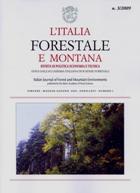Published
2013-04-17
Keywords
- Sahel,
- Acacia,
- reforestation,
- arid environments,
- stereometric functions
Abstract
Toward a synthetic biomass evaluation method in reforestations of semi-arid zones. Limits and outlooks for algometric models at Keita, Niger. In the Sahel there have been important interventions of reforestations because of the progressive degradation of the forest resources due to the anthropic pressure and global warming in the last 30 years. Estimating biomass in forest stands is therefore essential for evaluating their efficacy. In this work an approach is proposed for current biomass estimations. Some allometric models were developed and analyzed in Acacia plantations in the Keita valley in Niger, and the effectiveness of using a generalized model for dominant species – Acacia seyal Del., A. raddiana Savi (syn. A. tortilis Hayne), A. nilotica (Guill. Et Perrott.) – is evaluated. Equations were built by taking the diameter at 0.80 m and the total height as independent variables. The regression analysis was made according to the ordinary least squares method on log-transformed observations because of the eteroschedasticity of stereometric relations. In addition, a comparison between models with or without species distinction is done in order to quantify the loss of precision. Each model shows a good estimative performance (R2>0.98, P<0.001). Nonparametric tests confirm that the three acacia species belong to the same statistical population. Therefore, in the specific condition of this region, the use of a multi-species model is possible without an excessive loss in precision. Results obtained in this work represent an important contribution to biomass estimations in semi-arid environments in terms of technical reproducibility and economic sustainability.


